#Stephen Decatur
Text
DUEL ME AT DENNY'S IHOP! 😤🔥🌊
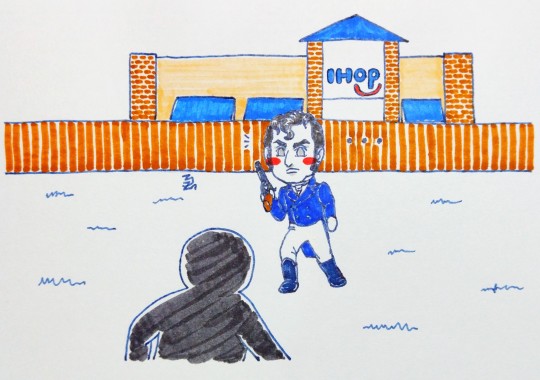
❌ FIGHT DUEL ME AT DENNY'S PARKING LOT!!!
✅ DUEL ME AT IHOP!!!1!!1!
James Barron totally said this y'all 🤪💀
.
I just found out recently that not much of the Bladensburg's Duelling Fields was preserved, so today the site where Stephen Decatur duelled James Barron was bordered by a cemetery and...an IHOP.
😅😅🥴🙃🥴
(so yeah, I reckon why not draw this 🤪🤪)
.
Meanwhile this was what their seconds were doing:

(Decatur's second William Bainbridge to the left, Barron's second Jesse Elliott on the right)
#drawing#original art#manga#illustration#traditional art#pen and ink#brush pen#fountain pen#comic strip#fan art#silent comic#it's crack o'clock folks#stephen decatur#james barron#←see how much i cared for him 😒#william bainbridge#american history#us navy#elliot drank cold brew coffee with cold vanilla cream 🙈#jesse elliott#1820s fashion#sort of
7 notes
·
View notes
Text
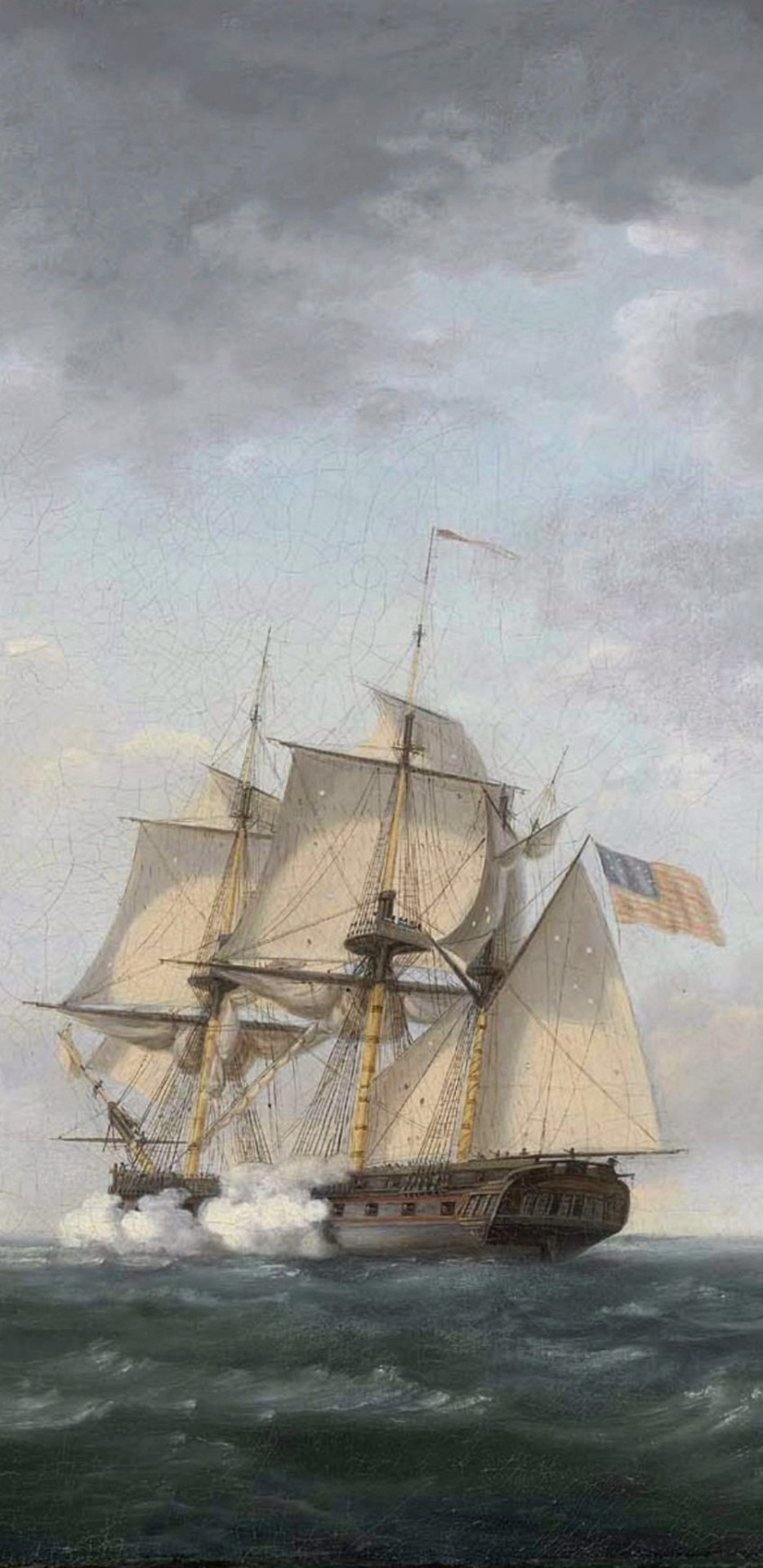
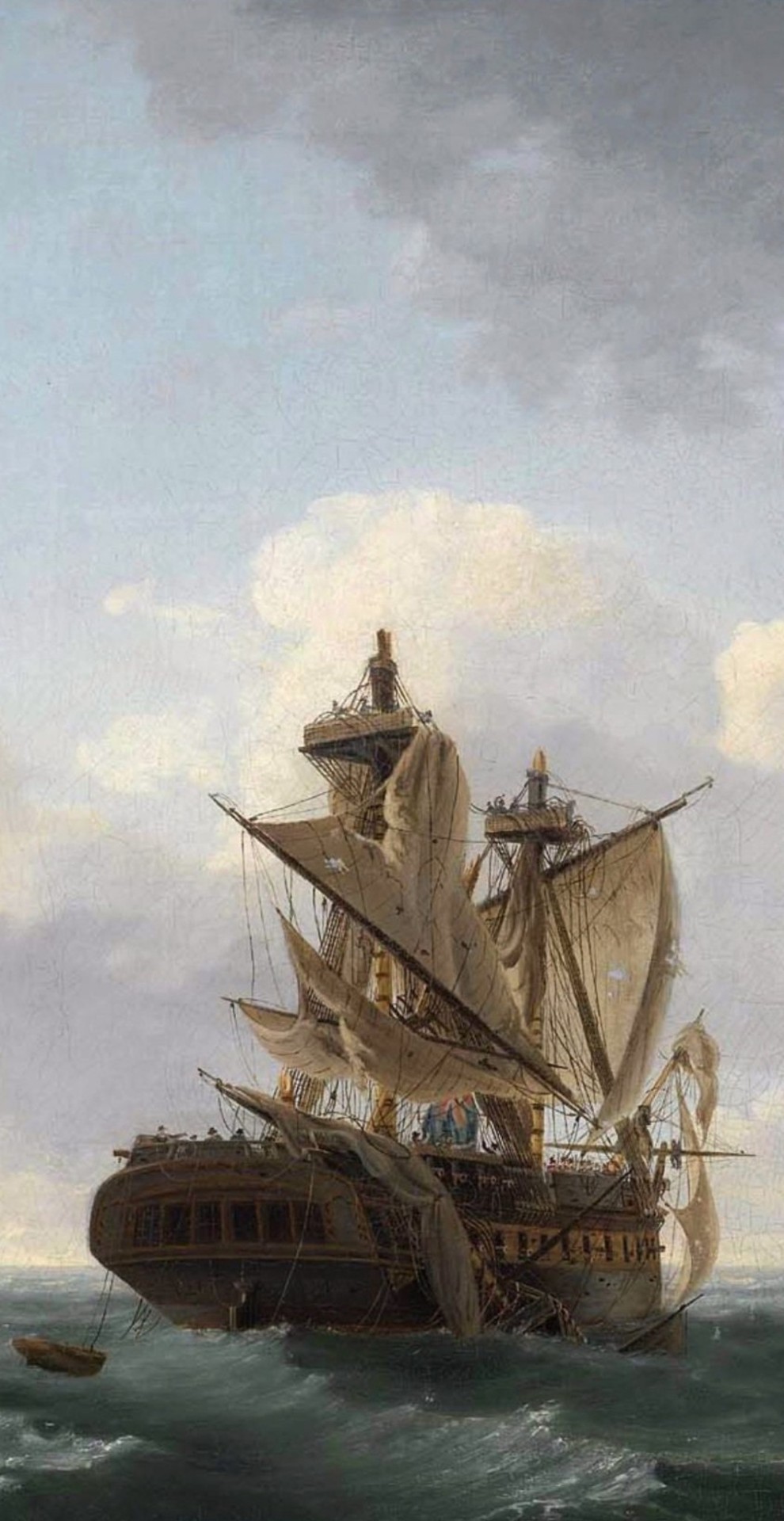
In early 1812, months before the outbreak of war, two captains of frigates from rival navies met in Norfolk. One was Stephen Decatur, who held the unofficial rank of commodore in the United States Navy and who was in command of USS United States. With him was the British John Surman Carden, in command of the crack new 38-gun frigate HMS Macedonian. The two socialised frequently during Carden’s stay in Norfolk, and Carden often dined with Decatur and his wife. The two officers took a liking to each other, bonding primarily through discussion of their beloved frigates. While United States was by far the slowest of the three heavy frigates with the nickname ‘Old Wagon’, she was still a prestigious command as one of the most powerful frigates in the world and currently carrying a slightly heavier armament than her sisters. Macedonian was considered an exceptionally fast frigate, and her first lieutenant, David Hope, considered her to be one of the best-trained frigates in gunnery in the world. It was reported that during one of Carden and Decatur's discussions they had joked about making a wager over a beaver hat on the outcome of a prospective contest between their two frigates.
— Nicholas James Kaizer, Revenge in the Name of Honour: The Royal Navy’s Quest for Vengeance in the Single Ship Actions of the War of 1812
Engagement between the ‘United States’ and the ‘Macedonian’ (details) by Thomas Birch, 1813. (Museum of Fine Arts, Boston)
When Carden and Decatur met again, 500 miles south of the Azores, it was an American victory, with the heavier armament of United States making the difference. Her longer, 24-pound shot proved decisive, inflicting much more damage than Macedonian’s 18-pound shot. At closer range, the Americans’ twenty-four 42-pound carronades devastated Macedonian, who carried only fourteen 32-pounders. Carden’s ship was nearly dismasted and became unmanageable, with great loss of life. Over 100 dead, dying, and wounded men were strewn near her wrecked rigging and canvas.
When Carden surrendered at last, some of his men cried and others were prepared to fight the American prize crew (the British sailors had also broken into the spirit stores, adding to the chaos). Nonetheless:
Decatur and Carden greeted each other as friends. The American refused to accept Carden’s sword and praised his gallantry, but he could tell that Carden was in a deplorably melancholic state. Carden admitted that he was devastated at losing his ship, believing that he was the first British captain to do so. Decatur’s attempts to console him by informing him that Dacres [of HMS Guerriere] had that unfortunate distinction only partially mollified Carden. He had still lost a ship in one-on-one combat, and Macedonian became the first and only British frigate to be brought into an American port as a prize.
— Nicholas James Kaizer, Revenge in the Name of Honour: The Royal Navy’s Quest for Vengeance in the Single Ship Actions of the War of 1812
No word from Kaizer if the bet for a beaver hat was ever called in by Stephen Decatur. For those unfamiliar with the term, it refers to a hat made from highly processed beaver fur that has been felted, formed, and brushed to a silken sheen, like the top hat worn by this gentleman in an 1812 fashion plate (Flickr):
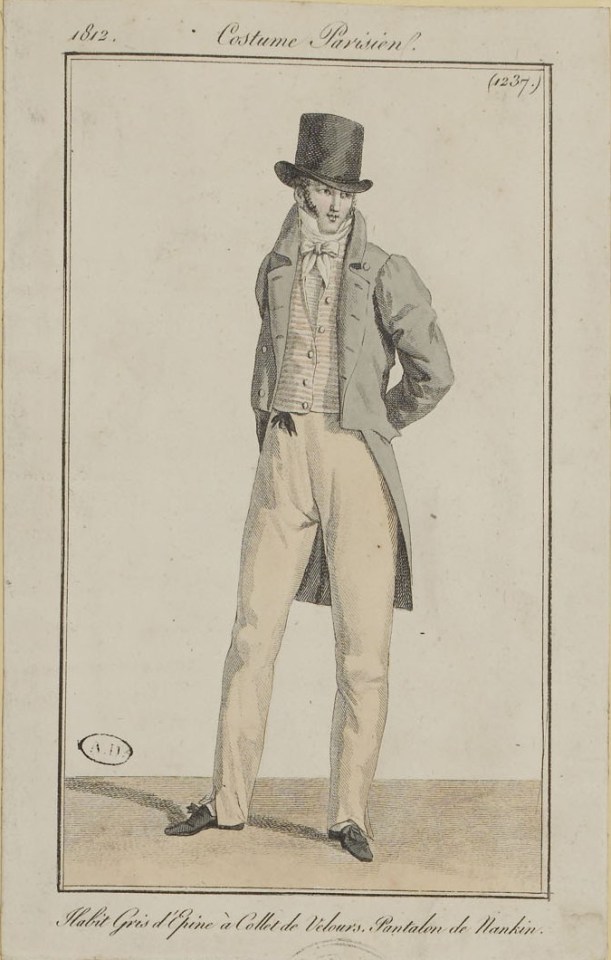
Beaver hats were also waterproof, and naval cocked hats were made out of the same material.
#War of 1812 Wednesday#war of 1812#age of sail#naval battle#naval history#age of fighting sail#uss united states#hms macedonian#royal navy#united states navy#military history#frigate#stephen decatur#us navy#john surman carden#thomas birch#naval art#maritime history#beaver hat#historical men's fashion#1810s#revenge in the name of honour#also can't believe we had an old ironsides and an old wagon#1812
32 notes
·
View notes
Text
Richard Somers's Ring
I love history and always have. I love reading or listening about olden times and seeing how much people have or haven't change. And if I'm lucky I might get a chance to discover something new and wonder if anyone else has noticed it. In the case I speak of Stephen Decatur and Richard Somers and the ring that was exchanged between them.
Years ago I was really, REALLY, into sailing adventures. I read Alexander Kent, C. S. Forester, Richard Woodman, almost all the Patrick O'Brian novels and loved them. I have a set of TIME/LIFE books about the age of sail and read up on the beginnings of the American navy, and that was my introduction to Stephen Decatur, the hero of Tripoli. Without getting too bogged down in the history at the turn of the 19th century Europe and the US were dealing with the Barbary pirates, who raided ships in the Atlantic and the Mediterranean taking slaves and plundering goods. The fledgling US tried dealing with this by paying tribute until Jefferson got fed up and tried sending his new navy overseas to deal with the problem. And two of the young captains sent there were Richard Somers and his good friend Stephen Decatur.

Stephen Decatur
Decatur's name might sound familiar; there are a bunch of towns, counties and schools named for him because he was a national hero. Fighting pirates will do that for a reputation. His good friend was Richard Somers, whom he went to school with before they joined the navy.

Richard Somers
If you know your Gay American history you'll know that these two men are thought to have been lovers and the similarities with them and Hamilton/Laurens are eery. They were said to be close and inseparable and they fought a duel together. (I refuse to go into the particulars, it was stupid). Like Hamilton Decatur was killed in a duel. Like Laurens Somers had no decent portraits and little interest in women. He also died young.

Somers's death is almost cinematic. It's 1804 and the first Barbary War is underway. Somers and Decatur are captains in a squadron sent to deal with the Tripolitan fleet in the harbor. The plan was to send a fire ship to blow up near the fort and take out the fleet as well. Somers along with 12 others volunteered to sail it into the harbor. It was not, strictly speaking, a suicide mission because the crew was suppose to light a fuse and disembark before mayhem ensued. But something went awry and the ship blew up prematurely, killing Somers and his crew.
But before he met his fate Richard took leave from his friend. I think he knew he might not survive and that's why he gave Stephen a ring. A gold ring, in fact, a ring that Decatur wore for the rest of his life.
A ring is a very intimate gift, it is the never ending circle, without beginning or end. Everlasting and forever. I could not find any information on the intertubes about men exchanging rings, in fact American men would not start wearing wedding bands until the next century. So when Decatur got married two years later the ring he wore on his hand for the rest of his life was given to him not by his wife but by the friend he had lost.
He was said to have been inconsolable after Richard's death and this has led some people to claim Decatur as a Gay icon. Randy Shilts does this in his book Conduct Unbecoming, and offers as further evidence Decatur's fourteen year marriage to Susan Wheeler which produced no children and may have lacked passion. So I decided to look into the matter myself and see what, if anything, was going on.
I do think the ring indicates an intimacy between Somers and Decatur. When Richard gave Stephen the ring he was asking for an acknowledgement of their bond, as well as a pledge not to forget him. And Stephen never did, as I said he wore that ring until the end of his life. But it's what happened to the ring after his death that I find interesting. So, let us turn our attention to the other half of the story...Decatur's childless marriage to Susan Wheeler.

Susan Wheeler Decatur
Shilts implies, as do a number of Gay history websites I perused, that Decatur married Susan because, well, that's what you did back then. He did famously say that the navy was his first love but was his marriage a sham? Not according to James Tertius de Key in A Rage for Glory. He says Decatur was already engaged to a woman in Philadelphia when he met Susan. In fact he broke off the engagement very soon after Susan came into his life. They met at a reception after Susan had seen his portrait...
... Susan had an opportunity to meet in person the subject of the painting, and to judge for herself the accuracy of his portrait. Whatever she may have thought of the likeness, she was much taken with the original. Decatur was equally smitten. He had just returned from foreign station after two years, and Susan Wheeler's grace and charm simply overwhelmed him. By the end of the evening, he was hopelessly, helplessly besotted with her.
Eventhough I think the author was really trying to sell the "love at first sight" angle Decatur really does seem to have wanted to marry Susan.
Susan was not exactly a blushing innocent. Well educated, charming,musically talented, and indulgently spoiled by her rich father, she had long been socially active. She was three years older than Decatur, and had in her time caught the eye of any number of prominent men throughout the Chesapeake region. She had already rejected the advances of Vice President Aaron Burr as well as those of Jerome Bonaparte, brother of the emperor of France.
Susan was also something of a woman of mystery. There were rumors that she was Wheeler’s illegitimate child, and had been born in the obscurity of Elk Ridge Landing, Maryland, where her father ran an ironworks. Nothing was known of her mother, but it was whispered in some quarters that she had been a mulatto, a particularly sinister accusation in the antebellum South. If Decatur got wind of any of these stories-and in all likelihood he did-they carried little weight with the lovesick captain.
[cue record scratch]
Wait, wait, Susan was part black? Well, well, so not only did Decatur dump a respectable girl from Philadelphia he did it so he could marry a thirty year old woman with dodgy racial origins from the backwoods of Maryland. If not for love what was Decatur's motivation?
(Oh, and if you're wondering how a woman like Susan would be allowed to pass into white society understand that at this time in America the racial boundaries were still getting sorted out. Since she looked white and no one was sure about her mother she was given the benefit of the doubt, so long as she did not express any crazy ideas about racial equality.)
I don't know why the Decaturs didn't have kids, but if I had to speculate (and I love to speculate!) maybe it was because neither of them wanted them. Plenty of women at that time had children well into their forties and if there was some physical reason Susan couldn't have children they could have easily adopted one. Maybe that was why Susan was still single at thirty, she was not interested in coupling and making babies and perhaps in Stephen Decatur she found a man who felt the same way. Think about if he had married into that Philadelphia family. What is the point of having a war hero in the family if he is not going to produce any little Stephen juniors? Maybe babies was the dealbreaker. Whatever they saw in each other they appear to have been warm and loving with each other, at least according to Decatur's recent biographers, who read the letters the couple exchanged. So even if Decatur's biographers are over selling the passion I think it wrong to depict Susan as little more than a beard.
In 1820 Decatur got into a disagreement with another navy man named James Barron. The two decided to duel it out, with the result that Barron and Decatur were wounded, Decatur dying shortly afterward. It was not a good death, he was in great pain and would not let Susan come to be with him. It sounds cold but do you really want your loved ones there to see you in intense pain? Particularly if their distress will only add to yours. His funeral was a big state affair but what caught my attention was what Susan did between her husband's death and his burial.
Before her husband was buried Susan had the ring removed from his hand. Was this so she could keep a prized possession? No, because she gave the ring away to a family friend, Francis Gurney Smith. (Smith's son donated it to the Smithsonian but it's not on display.) When I found out that this is what Susan did with the ring it got me thinking. Why did she do it? Now it is true that ten years later, when Susan was in financial difficulties, she did sell off a lot of her husband's memorabilia, but she wasn't hurting for funds at this time. And why give it to a family friend? Why not return it to Somers's sisters, they would have loved to have had something of their dead brother, buried in an unmarked grave in North Africa. She could have given it to someone in Stephen's family, but she didn't do that either, she gave it away to someone outside the family and I think that was intentional. Think about what that ring must have meant to Susan. Everyday of her marriage she would have had to see him wearing a ring given to him by another man. Her husband was not wearing a ring that symbolized their bond but his bond to another man. How many times did she have to watch Stephen look down at the ring and perhaps touch it, thinking about the man who had given it to him. That is why I think she gave to someone outside the family, she wanted out of her life and the lives of the people around her. She did not want to have to come into contact with it again.
And maybe that's the best evidence we'll have about Richard and Stephen.
8 notes
·
View notes
Text
La fragata del comodoro, una afrenta y los cañones de Decatur
La fragata del comodoro, una afrenta y los cañones de Decatur
El 2 de agosto de 1801 alcanzaba el puerto de Barcelona la fragata de guerra USS Essex de la marina norteamericana que iba al mando del capitán de fragata William Bainbridge. Procedía del puerto de Marsella y había tardado tres días en hacer la travesía. Con la fragata de guerra llegó otra civil de la misma nacionalidad que al mando del capitán Prince.
Llegada de la fragata norteamericana USS…

View On WordPress
0 notes
Text
Architectural Finds, 06/24/2023
My walk today was a brief 20 minutes, I was meeting up with a friend from upstate for some chai who had come down the night before to stay with some other friends. We met up at the Chai Spot on Mott St. (which I definitely now recommend) and we relaxed in their backroom lounge with our chai's for 45 min or so. She eventually had to leave to catch her bus back upstate & I walked her to the subway stairs hugged her and said goodbye. Feeling the warm weather on my skin and the caffeine in my veins I decided to walk up Broadway, here were some of the architectural highlights.
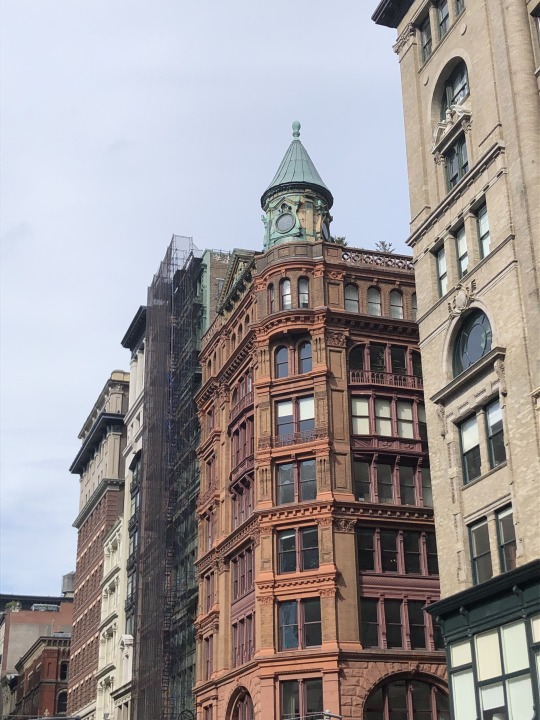
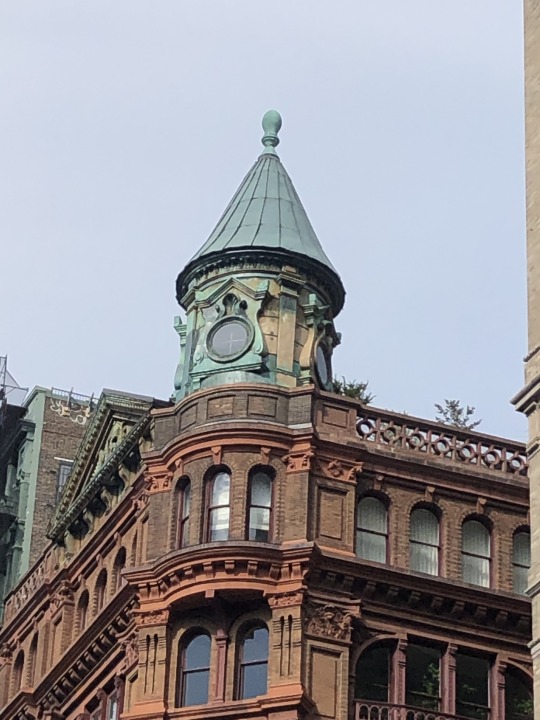
This cute turret room on the top of the building on the NE corner of Bleecker & Broadway. Doing the smallest ammount of googling I am finding out this was Peter Venkman's (Bill Murray) apartment in Ghostbusters 2???? ok.
It just looks like it would be such a whimsical little tower to hang your hair from, idk.
Building Facts: Built in 1891 as the Manhattan Savings Institution, also known as Bleecker Tower. Architect Stephen Decatur Hatch.
Built in the Romanesque Revival style with arches and ornaments, as well as the red sandstone and signature rough cut stone of this style on the base of the building (definitely why it caught my eye, I love Richardson Romanesque/romanesque revival).
The tower on top eludes my brief internet search, but if anyone has pictures of the inside please direct them to me.

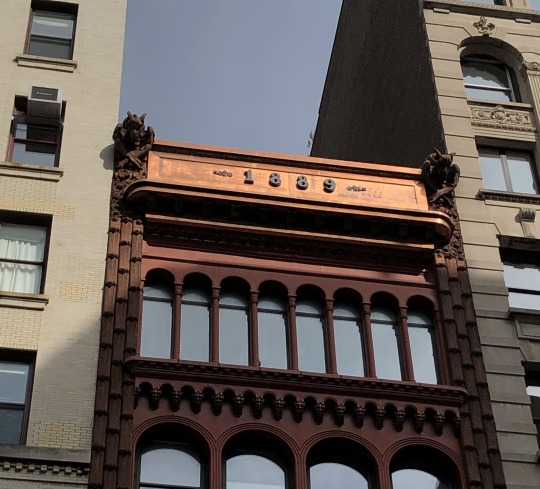
Next up we have this lil copper cutie who looks like it just got a face lift judging by the shiny copper facade on top. It is currently a FootLocker so hopefully they're treating her nice.
Building Facts: (obv) Built in 1889 by Architect Alfred Zucker.
The menacing gargoyles are cute.
(maybe more of an opinion than a fact, but) there used to be a bookstore called Shakepeare's on the bottom floor and the top floors were 1-per-floor studio spaces for artists to live/work in, & I wish that was the case today, not footlocker and high rent.

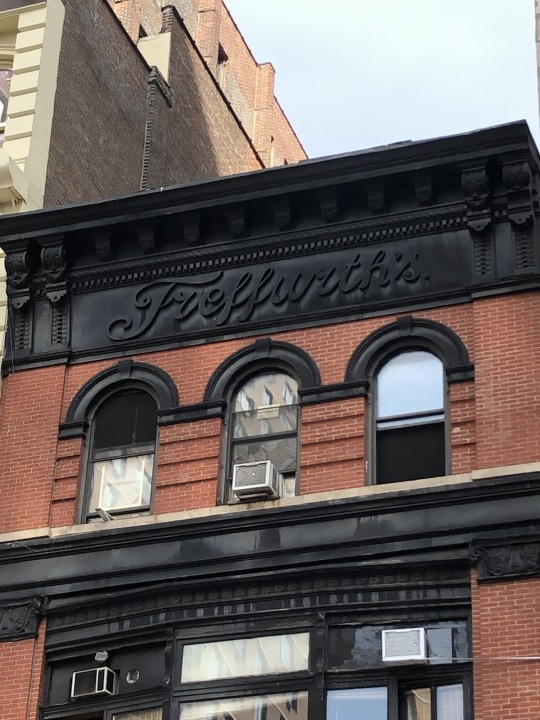
MOVING ON, we've got this pair of cuties. Don't they look like the best of friends holding hands ready to face the world side by side? These guys are 734 (left) and 732 (right) Broadway.
734: Built in 1872 by Architects David & John Jardine in Cast-Iron Neo-Grec style. Until ~2015, the facade had become a rusted brown/black mess until they cleaned and repainted it.
732: Built in 1854 by unknown.
This little building has a complicated past but ill try and summarize the small dig I just did on it. Originally it was a 3.5 peaked-roof building as a set of 3 houses for wealthy sisters (daughters of John Mason) from 732-736 designed by an undocumented architect. It underwent large renovations twice in its life, and one small renovation adding the Treffurth's sign on the roof cornice. The first renovation happened in 1885 by Henry Janeway Hardenbergh (god write a romance novel already would you) and allowed the introduction of E. A. Mac's bookstore to take the place of the earlier saloon on the bottom floor. It was then renovated in 1900 by Bruno W. Berger to the Cast-Iron more or less Renaissance Revival facade we see today.
-
Im going to keep these next ones brief because I'm beginning to lose steam :)

1 Astor Place
Built in 1883 by Architects Starkweather & Gibbs (they also designed the Potter Building). Brick & Terracotta above Cast-Iron ground floor facade.
Originally it was used as a hotel and boarding house with ground floor stores. The harsh vertical motifs on the exterior caught my eye, and I was drawn in even more by the harmony of the design elements and color choices.


10 Astor Place aka 444 Lafayette St
Built in 1876 by Architect Griffith Thomas to the same owner as the above building, Orlando B. Potter, who seemed to have impeccable taste in architecture.
I love the ornate implementation of the painted white Cast-Iron in the arches and pillar ornaments on this one. As well as the eye-popping contrast of the white paint on dark red brick, kind of a juxtaposed take on themes seen in the building above with the way the red and black elements seem to blend in together in harmony.

21 Astor Place aka Clinton Hall
Built in 1891 by George E. Harney.
Originally a Library for the New York Mercantile Library. I love the classic industrial look its such a strong look while they still tried to give elements of the facade some artistic nuance like in the arched windows and dark banding.

Only Caught the side of this Collonade building but doing more research on it, it's owned by the Blue Man Group????
Built 1831 by Seth Greer and historically home to family member's of the Astor & Vanderbilt families, it is the oldest building I took note of today.

And of course, how could I not be drawn into the Cooper Union Foundation building's charm. It stands seemingly so alone in the heart of Manhattan, close to a modern miracle.
Built in 1859 by Frederick A. Peterson in the (what I'm finding now to be called) Rundbogenstil German neo-Romanesque style.
I didn't realize it at the time but this picture also seems to be the back of the building. Still just such ornate and well-balanced design!
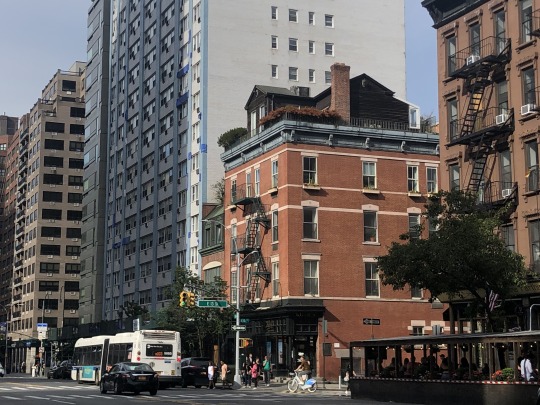


HONORABLE MENTIONS: This house on top of this building and the cute lil mansard moment next to it, which I searched and searched for but I cant seem to remember where it is.
Edit: I found it, there were street signs in the picture whoops. The one with the cottage is 203 E 13th Street also known as Pear Tree Place. And the little guy with the mansard roof is 109 3rd ave, both of them resting above Kiehls 3rd ave.
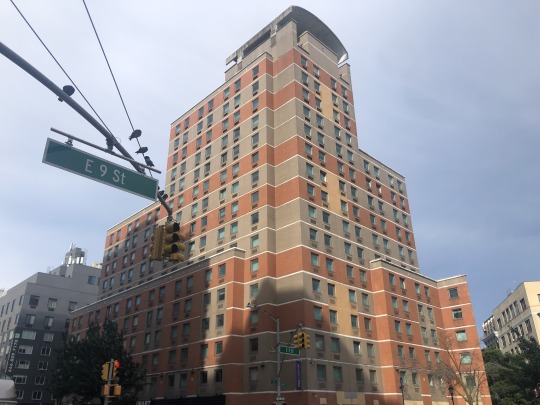
DISHONORABLE MENTIONS: This NYU Alumni building. Who designed you, they should be ashamed. What is going on with your offset, unbalanced terraces in the back? Awful. What was the point of all of these different colored brick patches?? Uncomfortable, awful. It looks like a neutral-toned Duplo set.
Built in 1986 and I cant even find the architect so you know they weren't very proud of it.
#architecture#manhattan#architect#Stephen Decatur Hatch#Alfred Zucker#Jardine#David & John Jardine#Henry Janeway Hardenbergh#Bruno W Berger#Starkweather & Gibbs#Orlando B Potter#Griffith Thomas#George E Harney#Seth Greer#Frederick A Peterson#Bleecker Tower#Manhattan Savings Institution#peter venkman#Ghostbusters II#Queen Anne#Romanesque#Richardson Romanesque#Gargoyles#Cast Iron#Neo-Grec#Greek Revival#Treffurths#Renaissance Revival#Astor Place#Clinton Hall
12 notes
·
View notes
Text

On 17 December, 1968, 20-year-old Barbara Mackle was at a Decatur, Georgia, hotel with her mother, Jane. She had been suffering from influenza, as was most pupils from the Emory University. Her mother had picked her up and taken her to a hotel to get over the sickness.
During the evening, Gary Stephen Krist knocked on the hotel door, claiming that Barbara’s boyfriend had been in a road traffic accident. As the women let him him, Krist and his accomplice, Ruth Eisemann-Schier, dragged the two women to the ground and placed a chloroform-soaked rag over their faces.
The duo then bound and gagged Jane before bundling Barbara into their car. They drove Barbara to a remote area in Gwinnett County where there was a pre-dug trench. Inside the trench was a fibreglass-reinforced box fitted with an air pump, a lamp and water and food laced with sedatives. Barbara was forced into the box.
Gary and Ruth demanded a $500,000 ransom from Barbara’s father, who was a wealthy land developer. The ransom drop was arranged, however two policemen driving by spooked the duo, leading them to flee on foot. When their car was searched, the found a photograph of Barbara inside the box, holding a sign which read “Kidnapped.” A second ransom drop was arranged and Ruth called the police, giving directions to where they could find Barbara. After spending three days trapped underground, Barbara was rescued.
Both Gary and Ruth were soon apprehended, with Ruth being the first women to appear on the FBI’s Ten Most Wanted. Ruth was paroled after four years while Gary was paroled after ten years.
61 notes
·
View notes
Text

Burning of Frigate USS Philadelphia in Tripoli Harbor in 1804, by Nicolino Calyo, (1799 1884)
It depicts USS Philadelphia, previously captured by the Tripolitans, ablaze after she was boarded by Stephen Decatur and 60 men and set afire, making their escape in the ketch Intrepid.
147 notes
·
View notes
Text

Memorial of the African-American People of Georgia in Favor of the Sumner Civil Rights Bill
Record Group 233: Records of the U.S. House of RepresentativesSeries: Petitions and Memorials Referred to the Committee on the JudiciaryFile Unit: Petitions and Memorials, Resolutions of State Legislatures, and Related Documents Which Were Referred to the Committee on the Judiciary during the 43rd Congress
Atlanta, Ga., Jan. 26th, 1874. Whereas, Hon. A. H. Stephens in his speech before Congress, January 5th, 1874, said that colored people of the State of Georgia did not desire the passage of the Civil Rights Bill; and whereas, the Georgia Legislature has also adopted resolutions, informing the Congress of the United States that the colored people of Georgia do not desire the passage of said Civil Rights Bill; and whereas, the allegations of Mr. Stephens and the Georgia Legislature are without foundation in fact: therefore, Resolved, That we, a portion of the colored citizens of Georgia, do most solemnly deny, both the speech of A. H. Stephens, and said Resolutions of the Georgia Legislature, so far as they relate to the colored citizens of this State being adverse to the passage of said Civil Rights Bill. Therefore, Resolved, That some arrangement be made by this meeting to deny the fact of the said assertions of Mr. Stephens, and the Georgia Legislature. 2. Resolved, That we, the citizens of the city of Atlanta, Ga., immediately inform the Congress of the United States, that we desire a speedy passage of the said Civil Rights Bill; and that we claim it as a right they owe us, as members of the Republican Party, and more particularly as citizens of the United States. 3. Resolved, That we most heartedly congratulate and thank Mr. Elliott, for his able and pointed speech, January 6th, 1874, in the House of Representatives of the United States, in behalf of the passage of the Civil Rights Bill, and in vindicating the ability and patriotism of the colored citizens of this country. Respectfully, J. O. WIMBISH W. D. MOORE, SECRETARY, J. B. FULLER, CHAIRMAN. Therefore, We, a committee appointed at a mass meeting of the colored citizens of the city of Atlanta, Ga., held on the 26th day of January, 1874, with power to forward on the above expression of eleven thousand of colored citizens of this City, do make this PETITION: To the Honorable Senate and House of Representatives: We, the undersigned committee, do hereby respectfully petition your honorable bodies to speedily pass the Civil Rights Bill, now under consideration in Congress, as the earnest request of the above stated citizens; wit hthe further request that your honorable bodies will, in view of the unjust manner in which we are now treated by the Legislature and the judicial tribunals in this State, enact such laws as, in your wisdom, are necessary to secure each citizen in the United States, without regard to race, color, or previous condition of servitude, equal civil and political rights, privileges and immunities before the law. And we your petitioners will ever pray. Dr. H. E. BAULDIN REV. ROMULUS MOORE C. WIMBISH C. H. MORGAN JAS. A. TATE. [Added by type beside list of names] Committee. We, the undersigned, members of the Georgia Legislature, fully endorse the above Resolutions and Petitions: T. G. CAMPBELL, SR. Ex. Senator 2d District. T. G. CAMPBELL, JR., Representative of McIntosh Co. I. H. ANDERSON, Senator 23d District. JASPER BATTLE, Representative of Thomas Co. A. J. NICHOLSON, Representative of Decatur Co. J. HEARD, Representative of Greene Co. JAMES B DEVEAUX, Senator 21st District. JAMES BLUE, Representative of Glynn Co. A. J. ATKINSON, Representative of Thomas Co. W. A. GOLDEN, Representative of Liberty Co.
19 notes
·
View notes
Photo

This Day in History: USS Philadelphia destroyed
On this day in 1804, Navy legend Stephen Decatur escapes from a harbor in Tripoli. Mere hours earlier, he’d led a mission to set a captured United States frigate ablaze.
Decatur’s feat has been called the “most bold and daring act of the age.” But why would a United States naval officer set an American ship on fire?
The audacious stunt occurred during the First Barbary War, soon after USS Philadelphia ran into an uncharted reef and was captured by the Tripolitans. She was a valuable prize! Once repaired, she would be the Barbary states’ most powerful warship. Meanwhile, the U.S. Navy had only one remaining ship as powerful as the one they’d lost: USS Constitution.
The story continues here: https://www.taraross.com/post/tdih-burning-uss-philadelphia
#tdih#otd#this day in history#history#history blog#America#freedom#liberty#us navy#naval history#sharethehistory
23 notes
·
View notes
Text
The sound of the engines and the smell of the grain
We go riding on the abolition grain train
Stephen A. Douglas was a great debater
But Abraham Lincoln was the great emancipator...
Denominator, go Decatur, go Decatur
(It's the great I Am)
Abominate her, go Decatur, why did we hate her?
(It's the great I Am)
Denominator, go Decatur, anticipate her
(It's the great I Am)
Appreciate her, appreciate her
Stand up and thank her
Stand up and thank her
(It's the great I Am)
Stand up and thank her
(It's the great I Am)
Stand up and thank her
(It's the great I Am)
Stand up and thank her
5 notes
·
View notes
Text
Horatio Hornblower...
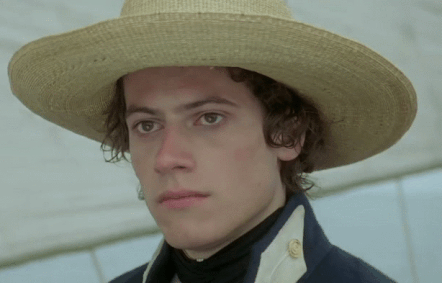
Stephen Decatur...

Something something classic repressed gay sailor look. ("But Shaun! Sennet hats are traditional!" My friend, that's just the inherent homoeroticism of the sea.)
15 notes
·
View notes
Text


hey y'all! it's been a while since i've made a playlist and for this one i decided to pick a history major theme. listen away!
↣ the great war by taylor swift | spotify | youtube | place a poppy in my hair, there’s no morning glory it was war it wasn’t fair
↣ the wreck of the edmund fitzgerald by gordon lightfoot | spotify | youtube | and later that night when his lights went outta sight came the wreck of the edmund fitzgerald
↣ soldier, poet, king by the oh hellos | spotify | youtube | there will come a soldier who carries a mighty sword, he will tear your city down
↣ decatur by sufjan stevens | spotify | youtube | stephen a. douglas was a great debater, abraham lincoln was the great emancipator
↣ achilles come down by gang of youths | spotify | youtube | loathe the way they light candles in rome, but love the sweet air of the votives
↣ vi. mishima / closing by philip glass and the carducci string quartet | spotify | youtube
↣ scarborough fair by simon & garfunkel | spotify | youtube | (war bellows blazing in scarlet battalions), parsley, sage, rosemary, and thyme
#starlightstudent#starlight student#starlight posts#playlist#music#study playlist#study music#studyblr#studyblr music#studyblr playlist#history#history major#history music#historian#study#studying#taylor swift#the great war#sufjan stevens#edmund fitzgerald#the wreck of the edmund fitzgerald#soldier poet king#achilles#achilles come down#philip glass#scarborough fair#simon and garfunkel#music suggestions
8 notes
·
View notes
Photo

There have been many claims of sightings and occurrences involving the Jersey Devil.
According to legend, while visiting the Hanover Mill Works to inspect his cannonballs being forged, Commodore Stephen Decatur sighted a flying creature and fired a cannonball directly upon it, to no effect.
Joseph Bonaparte, elder brother of Napoleon, is also claimed to have seen the Jersey Devil while hunting on his Bordentown estate about 1820.
During 1840, the Jersey Devil was blamed for several livestock killings. Similar attacks were reported during 1841, accompanied by tracks and screams.
In Greenwich during December 1925, a local farmer shot an unidentified animal as it attempted to steal his chickens, and then photographed the corpse. Afterward, he claimed that none of 100 people he showed it to could identify it. On July 27, 1937, an unknown animal "with red eyes" seen by residents of Downingtown, Pennsylvania was compared to the Jersey Devil by a reporter for the Pennsylvania Bulletin of July 28, 1937. In 1951, a group of Gibbstown, New Jersey boys claimed to have seen a 'monster' matching the Devil's description and claims of a corpse matching the Jersey Devil's description arose in 1957. During 1960, tracks and noises heard near Mays Landing were claimed to be from the Jersey Devil. During the same year the merchants around Camden offered a $10,000 reward for the capture of the Jersey Devil, even offering to build a private zoo to house the creature if it was captured.
During the week of January 16-23 of 1909, newspapers published hundreds of claimed encounters with the Jersey Devil from all over South Jersey and the Philadelphia area. Among these alleged encounters were claims the creature "attacked" a trolley car in Haddon Heights and a social club in Camden. Police in Camden and Bristol, Pennsylvania supposedly fired on the creature to no effect. Other reports initially concerned unidentified footprints in the snow, but soon sightings of creatures resembling the Jersey Devil were being reported throughout South Jersey and as far away as Delaware and western Maryland. The widespread newspaper coverage created fear throughout the Delaware Valley prompting a number of schools to close and workers to stay home. Vigilante groups and groups of hunters roamed the pines and countrysides in search of the Devil. During this period, it is rumored that the Philadelphia Zoo posted a $10,000 reward for the creature. The offer prompted a variety of hoaxes, including a kangaroo equipped with artificial claws and bat wings.
17 notes
·
View notes
Text
This is Commodore Stephen Degator:

[ID: An American alligator as American naval officer Commodore Stephen Decatur in the style of the portrait below. End ID.]

[ID: The original portrait of Commodore Stephen Decatur painted by John Vanderlyn in 1815. End ID.]
#catherine miller art#catherine miller#gator#LOL#not my art !! i bought a few of her cards at a convention and i wanted to share because i love them#mine
5 notes
·
View notes
Photo



The kidnapping of Barbara Mackle on December 17, 1968, reads like a scene from a horror movie. The young 20-year-old Emory University student was recovering from the flu with her mother at a Decatur, Georgia hotel when two people burst into the room. Gary Stephen Krist, along with Ruth Eisemann-Schier, had concocted a twisted plan to extort money from Barbara’s wealthy father.
With a chloroform-soaked rag, the attackers subdued the two women and dragged them out of the hotel room. They then whisked Barbara away to a remote location in Gwinnett County where they had pre-dug a trench. There, they had prepared a fiberglass-reinforced box fitted with an air pump, food, water, and a lamp laced with sedatives. They put Barbara inside the box and demanded a staggering $500,000 ransom from her father.
The FBI and local police were soon hot on their trail. A ransom drop was arranged, but two police officers driving by spooked the kidnappers and forced them to flee on foot, leaving Barbara trapped underground for three agonizing days. Miraculously, she was rescued unharmed, but the kidnappers were soon apprehended.
Krist and Eisemann-Schier were both eventually caught and sentenced to prison, with Eisemann-Schier becoming the first woman to ever appear on the FBI’s Ten Most Wanted list. Shockingly, Ruth was paroled after just four years, while Gary was released after serving ten years in prison.
61 notes
·
View notes
Text

USS United States, by Geoff Hunt (1948-)
The U.S.S. United States was a 44 Gun Heavy Frigate. The first of the American super-frigates, completed at Philadelphia in 1797 to designs by Joshua Humphreys, this powerful ship could carry over 50 guns. Under Stephen Decatur’s command, she out-fought and captured the British frigate Macedonian on 25 October 1812.
81 notes
·
View notes